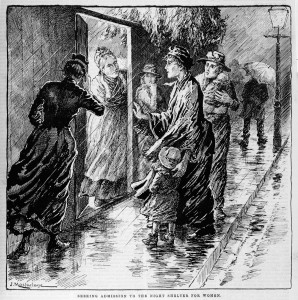
Collingwood is an inner city Melbourne suburb, one of the oldest in the city, with the first subdivisions and land sales in 1839, only four years after European settlement of Melbourne. The area on the slopes of a hill that falls down to flat piece of ground and then the Yarra river was originally inhabited by the Wurundjeri people who fished and hunted the rich wildlife of the area, as well as holding ceremonies that revolved around the waterways. Originally part of the same suburb as modern Fitzroy, the City of Collingwood was established in 1855. It incorporated the modern suburbs of Collingwood, Clifton Hill and Abbotsford, an area of 5.33km2.
The 1850s saw rapid development, spurred on by the enormous population surge, partly the result of the goldrush that began in 1852. Due to its proximity to the river and its supposedly unhealthy marshland, the suburb quickly became a favoured location for noxious trades, such as factories, breweries, quarries and brickmaking works. One author has observed the rapid rate of industrialisation: with the number of industrial businesses increasing from 41 in 1865 to 240 in 1875.
Divided into small allotments with basic wooden cottages, the suburb was heavily populated by the workers from these businesses who could easily access their jobs on foot from their homes. The population grew rapidly along with industry. By 1861 the suburb had 12,653 residents, rising to 18,600 in 1871 and 35,403 in 1891, with most people living in houses of two to three rooms. Today the same area has a population of around 17,000.
The suburb remained a largely working class area for much of its history, although with some diversity and pockets of middle class to wealthier residents, particularly evidenced by larger houses constructed during the 1880s land boom. Some of Australia’s best-known businesses had their beginnings in the factories and shops in the area, including one of the country’s major grocery chains, Coles. Historically the suburb has been demonised as an area of poverty and disadvantage and repeatedly the focus of urban reformers almost since its beginnings. This is particularly visible today in the highrise public housing estates that were constructed in the late 1960s, replacing large numbers of older workers cottages.
Collingwood has continued to be characterised by population fluctuations and demographic change, particularly in the Postwar period, which saw a shift in the community from a largely British ancestry to a diversity of ethnicities, driven by waves of immigration that characterised the era. During the 1950s to 70s Collingwood increasingly became an area that new migrants, including Greeks, Italians, Macedonians, Lebanese and Vietnamese, settled and began to raise families. The demographic of the area changed dramatically with Australian-born residents falling to half the population.
In 1994 the City of Collingwood was amalgamated into the much larger City of Yarra, which also encompasses Richmond, Fitzroy and parts of Carlton North, Fairfield and Alphington. The contemporary suburb of Collingwood, in which Collingwood College is located, covers a small 1.45km2 area of land, divided from the surrounding suburbs by three major arterial roads – Hoddle Street, Alexandra Parade and Victoria Parade – with Smith Street providing a liminal barrier with Fitzroy. It has over the last few decades continued to attract those seeking lower priced accommodation within an inner urban setting and become characterised as somewhat bohemian with its mix of cafes, galleries and bars. But it continues to maintain tradition of industry, particularly warehouses, throughout significant areas of the suburb.
Most recently it has again become a significant site of urban change. Collingwood saw a population increase during the decade after 2000, with the increased construction of housing stock in the area. Most recently this is evident in the development of large private apartment projects, some of which have incorporated adaptive reuse of industrial sites. At the time of writing there were around sixteen apartment buildings about to open, under construction, or under planning review, each ranging from around 20 to 700 apartments. These developments will almost certainly introduce significant change once again, increasing Collingwood’s population and changing its socioeconomic level dramatically, but also bringing into sharper light the disadvantage experienced by some members of the community.
References & Further Reading
Jill Barnard, ‘Collingwood’, eMelbourne: The City Past & Present
Tony Birch, ‘”These children have been born in an abyss”: slum photography in a Melbourne suburb’, Australian Historical Studies 123 (2004): 1–15
Collingwood Historical Society Website
Colllingwood History Committee, In those days: Collingwood remembered (Carringbush: Carringbush Regional Library in association with the City of Collingwood)
Karen T. Cummings, Bitter roots, sweet fruit: a history of schools in Collingwood, Abbotsford and Clifton Hill (Abbotsford: Collingwood Historical Society, 2008)
J. L. Fitzgerald, S. Broad & A. Dare, ‘A brief history of Fitzroy/Collingwood’, Regulating the street heroin market in Fitzroy/Collingwood (Melbourne: The University of Melbourne and Vic Health, 1999)
Fitzrovians, School of Historical Studies, University of Melbourne, Reflections of Fitzroy (Melbourne : School of Historical Studies, University of Melbourne, 2008)
G. M. Hibbins, A short history of Collingwood (Abbotsford: Collingwood Historical Society, 1996)
Andrew Lindsay & Don Whyte, Dancing in the kitchen: portraits of Collingwood’s older women (Collingwood: North Yarra Community Health Inc., 1994)
Andrew Lindsay & Ari Hatzis, When fish had feathers: portraits of Collingwood’s older men (Collingwood: North Yarra Community Health Inc., 2002)
Janet McCalman, Struggletown: public and private life in Richmond, 1900–1965 (South Melbourne: Hyland House Publishing, 1998)
‘Project Database’, Urban Melbourne Website
John Ventura, Growing up in Collingwood, 1943–1955: a memoir (Reservoir: John Ventura, 2007)
The Victorian Council of School Organizations, The problems of inner-suburban schools: a report of a seminar conducted by the Victorian Council of School Organizations, September 1967 (Melbourne: VISCP, 1967)
John Young, The School on the flat: Collingwood College, 1882–2007 (Collingwood: Collingwood College, 2007)